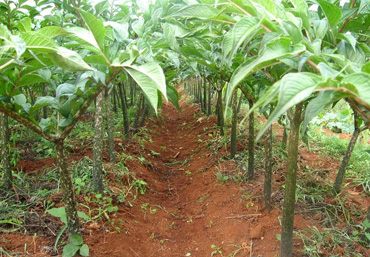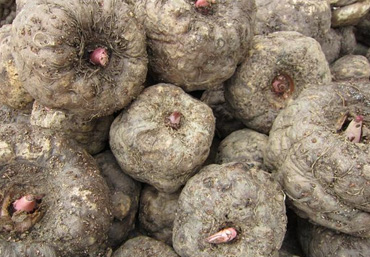Konjac powder is a very Alkaline food. Below you will find a list of alkaline foods that are commonly consumed. The most alkaline ingredient is the Wakame, a type of seaweed with an value 260.8. The second highest level of alkalinity is the Konjac glucomannan fiber (Konjac flour) with a value of 56.2.
Food pH List Dr. Kotaro Nishizaki (Japan)
| Food | Alkalinity | |
|---|---|---|
| Milk and eggs | Protein | 3.2 |
| Human milk | 0.5 | |
| Milk | 0.2 | |
| Beans and Products | Lentils | 1.8 |
| Soybean | 10.2 | |
| Onobrychis | 7.3 | |
| Pea clip | 1.1 | |
| Tofu | 0.1 | |
| Vegetables | Konjac Flour | 56.2 |
| Red ginger | 21.1 | |
| Spinach | 15.6 | |
| Summarized dishes | 10.6 | |
| Taro | 7.7 | |
| Lettuce | 7.2 | |
| Carrot | 6.4 | |
| Komatsu dishes | 6.4 | |
| Beijing cuisine | 6.2 | |
| Lily | 6.2 | |
| 3 leaf | 5.8 | |
| Potato | 5.4 | |
| Burdock | 5.1 | |
| Cabbage | 4.9 | |
| Radish | 4.6 | |
| Pumpkin | 4.4 | |
| Bamboo | 4.3 | |
| Potato | 4.3 | |
| Wu | 4.2 | |
| Small taro | 4.1 | |
| Lotus | 3.8 | |
| Cucumber | 2.2 | |
| Eggplant | 1.9 | |
| Onion | 1.7 | |
| Wei | 1.6 | |
| Mushroom | Shiitake | 17.5 |
| Matsutake | 6.4 | |
| Shimeji | 3.7 | |
| Seaweed | Wakame | 260.8 |
| Kelp | 40.0 | |
| Pickles | Yellow turnip | 5.0 |
| Assorted pickles(Mascot dishes) | 1.3 | |
| Fruits | Banana | 8.8 |
| Chestnut | 8.3 | |
| Strawberry | 5.6 | |
| Orange | 3.6 | |
| Apple | 3.4 | |
| Persimmon | 2.7 | |
| Pear | 2.6 | |
| Grape | 2.3 | |
| Watermelon | 2.1 | |
| Hobby Foods | Wine | 2.4 |
| Coffee | 1.9 | |
| Tea | 1.6 | |
| Food | Acidity | |
|---|---|---|
| Milk and eggs | Yolk | 19.2 |
| Cheese | 4.3 | |
| Fish and shellfish | Keng fillet | 37.1 |
| Bream eggs | 29.8 | |
| Squid | 29.2 | |
| Dried fish | 24.0 | |
| Tuna | 15.3 | |
| Octopus | 12.8 | |
| Carp | 8.8 | |
| Bream | 8.6 | |
| Oyster | 8.0 | |
| Health Salmon | 7.9 | |
| Eel | 7.5 | |
| Clam | 7.5 | |
| Scallops | 6.6 | |
| Eggs | 5.4 | |
| Loach | 5.3 | |
| Abalone | 3.6 | |
| Shrimp | 3.2 | |
| Meat | Chicken | 10.4 |
| Horse | 6.6 | |
| Pork | 6.2 | |
| Beef | 5.0 | |
| Chicken Soup | 0.6 | |
| Beans | Groundnut | 5.4 |
| Vicia | 4.4 | |
| Pea | 2.5 | |
| Fried Tofu | 0.5 | |
| Slightly fried bean curd | 0.2 | |
| Miso | 0 | |
| Sauce | 0 | |
| Vegetables | Arrowhead | 1.7 |
| White asparagus | 0.1 | |
| Seaweed | Nori (dried) | 5.3 |
| Grain | Bran | 85.2 |
| Bran | 36.4 | |
| Oats | 17.8 | |
| Pei Yami | 15.5 | |
| Broken wheat | 9.9 | |
| Buckwheat | 7.7 | |
| Rice | 4.3 | |
| Barley | 3.5 | |
| Flour | 3.0 | |
| Bran | 3.0 | |
| Bread | 0.6 | |
| Beverages | Lees | 12.1 |
| Beer | 1.1 | |
| Sake | 0.5 | |
| Dairy | Cream | 0.4 |
Eat more fresh vegetables, fruits and Konjac noodles can be very helpful to balance the bodies pH.
It is important to balance food intake of alkaline foods with acidic foods. Of course, nutritional balance and acid-alkaline balance is a big difference in thinking. While nutrition is concerned with the balance of nutrients, the acid-alkaline balance is another important balance to a healthy lifestyle. With the common ingredients in American kitchens such as soda, prepared foods and red meats, it is important to consumer alkaline foods to balance the acidic nature of the common American diet..
Alkaline foods include most vegetables, fruits and seaweed. Most animal foods are acidic foods such as fish, meat, shellfish. Most cereals and some nuts, are acidic foods as well.
Food for human beings are basically divided into five categories: protein, fat, carbohydrates, vitamins and minerals. For humans, the pH of certain minerals in food can contribute to the alkaline-acidic balance. These minerals include potassium, sodium, calcium, magnesium, iron, phosphorus, chlorine, sulfur.
Ideally, your blood pH should be 7.36. It is important that we maintain a balanced pH of between 7.2 and 7.4. This is essentially a neutral pH. However, due to poor diets of junk food, fast food, over-cooked, processed foods and soft drinks, the pH of our bodies are often on the acidic side. The pH of soft drink ranges from 2.5-3.4 which generates a highly acidic environment in the stomach. This is several thousand times more acidic than our bodies. This is important because all diseases start and live and thrive in an acidic environment and do not live well in an alkaline environment. Thus it follows that to keep ourselves as alkaline as possible. The argument can be made that our acidic food habits contribute to the development of disease which is why it is important to consume foods that are alkaline as well.
A Foods acidic or alkaline-forming tendency in the body has nothing to do with the actual pH of the food itself. For example, lemons are very acidic, however the end-products they produce after digestion and assimilation into the body are very alkaline. For this, lemons are alkaline-forming foods in the body. Likewise, meat will test alkaline before digestion but it leaves very acidic residue in the body after digestion. Nearly all animal products and meats are very acid-forming.
An acidic pH can occur from an acidic diet, emotional stress, toxic overload, and/or immune reactions or any process that deprives the cells of oxygen and other nutrients. The body will try to compensate for acidic pH by using alkaline minerals. If the diet does not contain enough minerals to compensate, a build up of acids in the cells will occur.
An acidic balance will decrease the body's ability to absorb minerals and other nutrients, decrease the energy production in the cells, decrease it's ability to repair damaged cells, decrease it's ability to detoxify heavy metals, make tumor cells thrive, and make it more susceptible to fatigue and illness.
The reason acidosis is more common in our society is mostly due to the typical American diet, which is far too high in acid producing animal products like meat, eggs and dairy, and far too low in alkaline producing foods like fresh vegetables. Additionally, we eat acid producing processed foods like white flours, sugars and acidic drinks. We use artificial chemical sweeteners like NutraSweet, Spoonful, Sweet 'N Low, Equal and Aspartame, all of which are extremely acid forming. One of the best methods to increase the positive nutritional elements of your diet is to reduce the number of acidic foods.
Konjac Foods are a very high alkaline foods, rich in calcium, pure fiber and zero calories. Consuming Konjac foods regularly is a great habit to balance your overall pH. In the United States, you can find Konjac Foods in most Japanese supermarkets. Konjac foods also go by the name of konnyaku in Japanese. If you cannot find Konjac foods in your local area you can order a large variety of Konjac products from the Konjac website konjacfoods.com



Copyright © 2002 ~ 2017 KonjacFoods.com